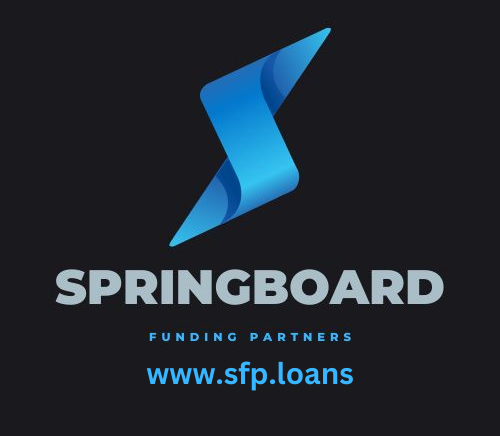Your Partner in Growth
Commercial Real Estate
Significant experience in securing Acquisition, Construction, Refi and Refi/cash out Financing
Countless Commercial real estate and investment rental owners have turned to Springboard Funding Partners due to my extensive direct lender relationships built over the past 12 years. Why count on one lender to approve your loan when I can analyze your request and reach out to the right parties in my lending network in an effort to get your the approval you are depending on.
Work with Us
Who makes up our direct real estate lending network?
Senior loans/ First position loans
- Community Banks
- Regional Banks
- Credit Unions
- Life insuraance companies
- Private Capital Sources
- Non Bank SBA lenders
- Down payments often as low as 10-20%
Bridge lenders / Second position
- Bridge lenders take on tough deals
- 60%-65% LTV
- Damaged credit applicants considered.
- CPACE providers – Can add up to 30%-35% on top of first mortgage.
- CPACE is non recourse, 25-30 year am.
- Cash flow assignment funding source.
- 20X the monthly net income from a cash flowing hotel, multi family, student or senior housing property.
Asset classes preferred
- Multi family
- Mixed Use
- Industrial
- Retail – Shopping Centers
- Medical
- Warehouse
- Student Housing
- Senior Living
Why partner with us on your real estate request?

Put my experience to work
I work closely with direct lending executives from a diverse network of lenders.
I have facilitated hundreds of loans since 2013 and each deal brought with it a unique set of circumstances.
A number of closings I have facilitated were denied or passed on before we were able to get to work.

Multiple lender options
We do not call one of two banks and hope for the best.
After I have a fact finding call with the borrower, I can determine what type of lender is best for the specific request. From there, I will reach out to a half dozen to gauge their interest, structure and current rates.
Whether your are looking for a senior or first position loan, a bridge loan, or CPACE funding, we have capital providers ready to help.

Competitive Fees
My firm only charges a Success fee, due only if and when a loan we facilitate closes and funds.
Our fee is listed on the closing settlement statement and is distributed by the title company as part of the approved distributions at closing.
Out standard Success fee is 2% of the gross loan proceeds received.

Need a quick close?
Bridge lenders can often close in 10 days to 2 weeks.
Their focus is the value of the property relative to the loan you are seeking, along with the cash flow from the property to ensure there is sufficient income coming in to cover the payment.
In select cases, when significant equity is in the property, the bridge lender may close a loan with 12 months of interest reserve to cover the payments if necessary.
Our Unique Offerings
Qualification Requirements
To qualify for most commercial real estate or investment rental funding, borrowers typically need:
- Minimum credit score of 660+ (except in the case of a bridge loan)
- For SBA funding – 51% + owner occupancy of the property
- In many cases, income from the property has to cover all expenses with a 20% buffer.
- Clean payment history – no current litigation, bankruptcy.

Maximum loan to value?
- Financing up to 90% of an 51% +owner occupied property.
- Example – $1m property, up to a $900,000 loan upon certain conditions.
- Conventional loan to appraised value – 70%-75%.
- Bridge loan – 60%-65% loan to appraised value.
- Land Loan – 50% loan to appraised value.
Average term
- Senior Conventional Loan terms are often 5 year fixed with a 25-30 year amortization
- Adjustable rate terms can be 3,5,7,10 year terms with a 25 year amortization.
- Bridge loan terms are often interest only for 12-24 months.
- All loan to appraised value, rate, term, amortization and fees will be disclosed in the term sheet.
Straightforward Process
- We begin with the initial discovery call where we learn what the borrower is looking to accomplish and what obstacles may be in play.
- We request and review pertinent docs such as the most recent PL, rent roll, leases on the property as well as 2 to 3 years of property and borrower tax returns along with a personal financial statement from the borrower
- Next up – discussions with the right lender for the request, sharing all docs for underwriting and loan committee decision.
- Term sheet issued – review with the borrower, address all questions, confer with lender on borrower questions on the proposal.
- Appraisal and any third party reports, i.e. phase one and title ordered. Third party reports come back in 2 weeks roughly.
- Assuming no valuation or title surprises, lender commitment issued and accepted. Closing date scheduled.
- Loan closes and funds!
Get Started Today
There is plenty of capital looking for the right real estate deal. Let’s discuss how we can connect you with the ideal lending partner for your specifc request.
Note: Rates and terms are subject to credit approval and may vary based on the type of real estate owned, location, condition, credit profile, cash flow, loan amount requested vs the appraised value and market conditions. Contact our office for the most current financing options available.
Why Choose Us?
- Extensive lender network
- Competitive rates and terms
- Industry expertise
- Personalized service
- Quick approval process
- Ongoing support
Contact us today to learn more about how we can help your business acquire the equipment it needs to grow and succeed.

